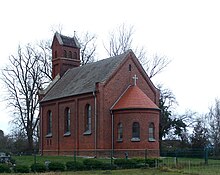Schwanebeck (Nauen)
|
Schwanebeck
City of Nauen
Coordinates: 52 ° 34 ′ 23 " N , 12 ° 47 ′ 35" E
|
|
|---|---|
| Height : | 41 m above sea level NN |
| Residents : | 241 (1971) |
| Incorporation : | May 19, 1974 |
| Postal code : | 14641 |
| Area code : | 033239 |
Schwanebeck has been part of the city of Nauen in the Havelland district in Brandenburg since May 19, 1974 .
Neighboring places
- Neukammer , part of the city of Nauen
geography
Schwanebeck is located about 7 kilometers southwest of Nauen at an altitude of 40 m above sea level. NHN . Located a little off the connecting road Nauen - Brandenburg (L71), the district can only be reached via Neukammer. The Berlin – Rathenow railway line cuts Schwanebeck from other neighboring towns.
history
In 1179 Schwanebeck was first mentioned as "villa Schwanebeke". It was mentioned as a branch of the church of Niebede , on the confirmation document of Bishop Siegfried II. From 1216 "Schwanebeke" can also be found as a branch in Niebede. For 1375 there are 22 hooves in the land register for Schwanebeck , one leaning shoulder with two leaning hooves and two leasing hooves and a jug . After 1375 Schwanebeck became desolate. In 1418 Schwanebeck was mentioned as "Heide zu Schwanebeck", which suggests that the village and the Feldmark were deserted . Mentioned in 1539 as Feldmark without a settlement, in 1574 those from Bredow received “the Feldmarcke swan pond” including the sheep farm. In 1565, two knight seats of von Bredow's were again recorded in Schwanebeck.
In 1624, a lease shepherd and servants can be found in Schwanebeck. In 1698, Henning Caspar II von Bredow (* 1658; † July 19, 1715) became master of Schwanebeck. In 1745 Schwanebeck was run as a dairy and sheep farm, but in 1754 it was run as the Vorwerk of the Bredower estate in Markau . 1788 inherited Asmus Wilhelm von Bredow (1731–1799) Herr auf Gut Prillwitz near Hohenzieritz / Neubrandenburg the Gut Markau including the Vorwerk Schwanebeck from his cousin Henning Caspar IV von Bredow (1742–1788). From 1788, Asmus Wilhelm von Bredow had a simple but noble mansion built in Schwanebeck. Asmus Wilhelm von Bredow's former ward Christoph August von Bredow (1780–1844), a direct descendant of Henning Caspar II von Bredow , inherited the former Vorwerk after the death of Asmus Wilhelm von Bredow in 1799, which has since developed into Gut Schwanebeck.
Christoph August von Bredow , an admirer of Albrecht Daniel Thaer (1752–1828), developed the Schwanebeck estate into a model estate by 1820 based on his theories of modern agriculture. When he died in 1844, he is said to have been buried in the church in Schwanebeck. However, there is a rumor and probably also indications that he was buried in the manner of Old Fritz together with his favorite horse on the south side not far from the Schwanebecker See. Christoph August von Bredow followed Karl Friedrich Wilhelm von Bredow (1796–1862) as landlord in Schwanebeck; the latter had the Schwanebeck manor house enlarged. The enlarged mansion grew into an eleven-axis building with a stately living area on an unusually high base. Until 1910 it remained the residence of von Bredow.
In 1870 Schwanebeck got its own school with a classroom and a teacher's apartment. From 1945 to 1965 it was run as a one-room school for grades 1 to 3. Then the children had to go to school in Groß Behnitz or Nauen.
Count Wilhelm Heinrich von Redern (* 1888; † December 14, 1914 in the Battle of Ypres), a great-nephew of Friedrich Wilhelm von Redern , acquired the Schwanebeck estate before the First World War . Countess Viktoria Maria von Redern , the sister of Count Wilhelm Heinrich von Redern , inherited the Schwanebeck estate and leased it on. The hemp producer Arthur Schurig (born July 19, 1869 in Gröbers ; † 1932) was one of the tenants between the two world wars.
In 1917 there were 475 inhabitants in the Schwanebeck manor. In Schwanebeck itself lived 173 inhabitants in 1875, 151 (1890), 155 (1910), 315 (1925), 197 (1933), 202 (1939), 368 (1946), 400 (1950), 274 (1964) and 241 inhabitants (1971).
After 1945 displaced persons found new accommodation in the manor house and the land belonging to it became land reform land . Subsequently, the agricultural areas followed the typical socialist path from LPG type I to LPG type III, merging with the Nauener LPG. This was followed in 1974 by the amalgamation of the districts, since then Schwanebeck has been a district of the city of Nauen.
The remains of the manor house were demolished in 2003, previously it was used for residential purposes, as a restaurant and as a sales point. It had been empty since 1986 and became increasingly dilapidated after a fire in 2000.
Footnotes
- ^ Brandenburgisches Landeshauptarchiv ( Memento from September 5, 2012 in the web archive archive.today )
- ↑ a b c d e f g Günter Mangelsdorf: Die Ortswüstungen des Havelland, page 123, de Gruyter Berlin 1994, ISBN 3-11-014086-1
- ^ A b Reinhard E. Fischer : Brandenburg name book. Part 4: The place names of the Havelland. Böhlau, Weimar 1976
- ↑ a b The radio town of Nauen - OT Schwanebeck ( Memento of the original from March 20, 2007 in the Internet Archive ) Info: The archive link was automatically inserted and not yet checked. Please check the original and archive link according to the instructions and then remove this notice.
- ↑ Susanne Köstering, Renate Rüb: Yesterday's trash? An environmental historical exploration in Berlin and Brandenburg, page 91ff, Waxmann Verlag 2003, ISBN 978-3-8309-1258-3
- ↑ State Office for Data Processing and Statistics (LDS) - Contribution to statistics - Historical municipality directory of the State of Brandenburg from 1875 to 2005 - Havelland district from December 2006
